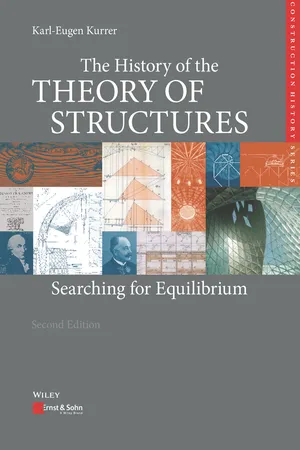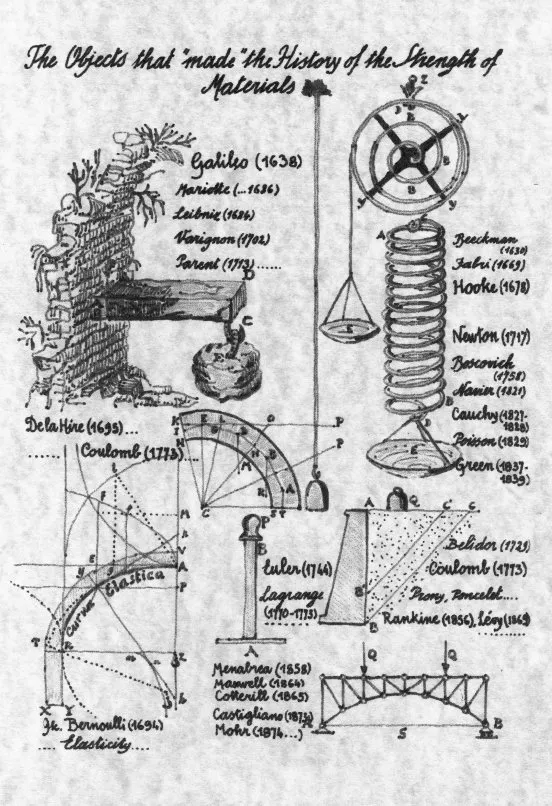
The History of the Theory of Structures
Searching for Equilibrium
- English
- ePUB (mobile friendly)
- Available on iOS & Android
About This Book
Ten years after the publication of the first English edition of The History of the Theory of Structures, Dr. Kurrer now gives us a much enlarged second edition with a new subtitle: Searching for Equilibrium. The author invites the reader to take part in a journey through time to explore the equilibrium of structures. That journey starts with the emergence of the statics and strength of materials of Leonardo da Vinci and Galileo, and reaches its first climax with Coulomb's structural theories for beams, earth pressure and arches in the late 18th century. Over the next 100 years, Navier, Culmann, Maxwell, Rankine, Mohr, Castigliano and Müller-Breslau moulded theory of structures into a fundamental engineering science discipline that - in the form of modern structural mechanics - played a key role in creating the design languages of the steel, reinforced concrete, aircraft, automotive and shipbuilding industries in the 20th century. In his portrayal, the author places the emphasis on the formation and development of modern numerical engineering methods such as FEM and describes their integration into the discipline of computational mechanics.
Brief insights into customary methods of calculation backed up by historical facts help the reader to understand the history of structural mechanics and earth pressure theory from the point of view of modern engineering practice. This approach also makes a vital contribution to the teaching of engineers.
Dr. Kurrer manages to give us a real feel for the different approaches of the players involved through their engineering science profiles and personalities, thus creating awareness for the social context. The 260 brief biographies convey the subjective aspect of theory of structures and structural mechanics from the early years of the modern era to the present day. Civil and structural engineers and architects are well represented, but there are also biographies of mathematicians, physicists, mechanical engineers and aircraft and ship designers. The main works of these protagonists of theory of structures are reviewed and listed at the end of each biography. Besides the acknowledged figures in theory of structures such as Coulomb, Culmann, Maxwell, Mohr, Müller-Breslau, Navier, Rankine, Saint-Venant, Timoshenko and Westergaard, the reader is also introduced to G. Green, A. N. Krylov, G. Li, A. J. S. Pippard, W. Prager, H. A. Schade, A. W. Skempton, C. A. Truesdell, J. A. L. Waddell and H. Wagner. The pioneers of the modern movement in theory of structures, J. H. Argyris, R. W. Clough, T. v. Kármán, M. J. Turner and O. C. Zienkiewicz, are also given extensive biographical treatment. A huge bibliography of about 4, 500 works rounds off the book.
New content in the second edition deals with earth pressure theory, ultimate load method, an analysis of historical textbooks, steel bridges, lightweight construction, theory of plates and shells, Green's function, computational statics, FEM, computer-assisted graphical analysis and historical engineering science. The number of pages now exceeds 1, 200 - an increase of 50% over the first English edition.
This book is the first all-embracing historical account of theory of structures from the 16th century to the present day.
Frequently asked questions
Information
Chapter 1
The tasks and aims of a historical study of the theory of structures



1.1 Internal scientific tasks
Table of contents
- Cover
- Table of Contents
- Foreword of the series editors
- Foreword
- Preface to the second English edition
- About this series
- About the series editors
- About the author
- Chapter 1: The tasks and aims of a historical study of the theory of structures
- 1.1 Internal scientific tasks
- 1.2 Practical engineering tasks
- 1.3 Didactic tasks
- 1.4 Cultural tasks
- 1.5 Aims
- 1.6 An invitation to take part in a journey through time to search for the equilibrium of loadbearing structures
- Chapter 2: Learning from history: 12 introductory essays
- 2.1 What is theory of structures?
- 2.2 From the lever to the trussed framework
- 2.3 The development of higher engineering education
- 2.4 A study of earth pressure on retaining walls
- 2.5 Insights into bridge-building and theory of structures in the 19th century
- 2.6 The industrialisation of steel bridge-building between 1850 and 1900
- 2.7 Influence lines
- 2.8 The beam on elastic supports
- 2.9 Displacement method
- 2.10 Second-order theory
- 2.11 Ultimate load method
- 2.12 Structural law – Static law – Formation law
- Chapter 3: The first fundamental engineering science disciplines: theory of structures and applied mechanics
- 3.1 What is engineering science?
- 3.2 Subsuming the encyclopaedic in the system of classical engineering sciences: five case studies from applied mechanics and theory of structures
- Chapter 4: From masonry arch to elastic arch
- 4.1 The arch allegory
- 4.2 The geometrical thinking behind the theory of masonry arch bridges
- 4.3 From wedge to masonry arch or the addition theorem of wedge theory
- 4.4 From the analysis of masonry arch collapse mechanisms to voussoir rotation theory
- 4.5 The line of thrust theory
- 4.6 The breakthrough for elastic theory
- 4.7 Ultimate load theory for masonry arches
- 4.8 The finite element method
- 4.9 The studies of Holzer
- 4.10 On the epistemological status of masonry arch theories
- Chapter 5: The history of earth pressure theory
- 5.1 Retaining walls for fortifications
- 5.2 Earth pressure theory as an object of military engineering
- 5.3 Modifications to Coulomb earth pressure theory
- 5.4 The contribution of continuum mechanics
- 5.5 Earth pressure theory from 1875 to 1900
- 5.6 Experimental earth pressure research
- 5.7 Earth pressure theory in the discipline-formation period of geotechnical engineering
- 5.8 Earth pressure theory in the consolidation period of geotechnical engineering
- 5.9 Earth pressure theory in the integration period of geotechnical engineering
- Chapter 6: The beginnings of a theory of structures
- 6.1 What is the theory of strength of materials?
- 6.2 On the state of development of theory of structures and strength of materials in the Renaissance
- 6.3 Galileo’s Dialogue
- 6.4 Developments in strength of materials up to 1750
- 6.6 The formation of a theory of structures: Eytelwein and Navier
- 6.7 Adoption of Navier’s analysis of the continuous beam
- Chapter 7: The discipline-formation period of theory of structures
- 7.1 Clapeyron’s contribution to the formation of the classical engineering sciences
- 7.2 The completion of the practical beam theory
- 7.3 From graphical statics to graphical analysis
- 7.4 The classical phase of theory of structures
- 7.5 Theory of structures at the transition from the discipline-formation to the consolidation period
- 7.6 Lord Rayleigh’s The Theory of Sound and Kirpitchev’s fundamentals of classical theory of structures
- 7.7 The Berlin school of theory of structures
- Chapter 8: From construction with iron to modern structural steelwork
- 8.1 Torsion theory in iron construction and theory of structures from 1850 to 1900
- 8.2 Crane-building at the focus of mechanical and electrical engineering, steel construction and theory of structures
- 8.3 Torsion theory in the consolidation period of theory of structures (1900 – 1950)
- 8.4 Searching for the true buckling theory in steel construction
- 8.5 Steelwork and steelwork science from 1925 to 1975
- 8.6 Eccentric orbits – the disappearance of the centre
- Chapter 9: Member analysis conquers the third dimension: the spatial framework
- 9.1 The emergence of the theory of spatial frameworks
- 9.2 Spatial frameworks in an age of technical reproducibility
- 9.3 Dialectic synthesis of individual structural composition and large-scale production
- Chapter 10: Reinforced concrete’s influence on theory of structures
- 10.1 The first design methods in reinforced concrete construction
- 10.2 Reinforced concrete revolutionises the building industry
- 10.3 Theory of structures and reinforced concrete
- 10.4 Prestressed concrete: “Une révolution dans l’art de bâtir” (Freyssinet)
- 10.5 Paradigm change in reinforced concrete design in the Federal Republic of Germany, too
- 10.6 Revealing the invisible: reinforced concrete design with truss models
- Chapter 11: The consolidation period of theory of structures
- 11.1 The relationship between text, image and symbol in theory of structures
- 11.2 The development of the displacement method
- 11.3 The rationalisation movement in theory of structures
- 11.4 Konrad Zuse and the automation of structural calculations
- 11.5 Matrix formulation
- Chapter 12: The development and establishment of computational statics
- 12.1 “The computer shapes the theory” (Argyris) – the historical roots of the finite element method
- 12.2 The matrix algebra reformulation of structural mechanics
- 12.3 FEM – formation of a general technology of engineering science theory
- 12.4 The founding of FEM through variational principles
- 12.5 Back to the roots
- 12.6 Computational mechanics
- Chapter 13: Thirteen scientific controversies in mechanics and theory of structures
- 13.1 The scientific controversy
- 13.2 Thirteen disputes
- 13.3 Résumé
- Chapter 14: Perspectives for a historical theory of structures
- 14.1 Theory of structures and aesthetics
- 14.2 Historical engineering science – historical theory of structures
- Chapter 15: Brief biographies of 260 protagonists of theory of structures
- Bibliography
- Name index
- Subject index
- End User License Agreement